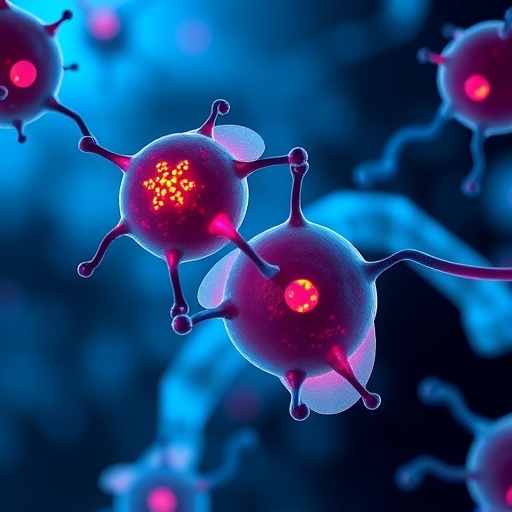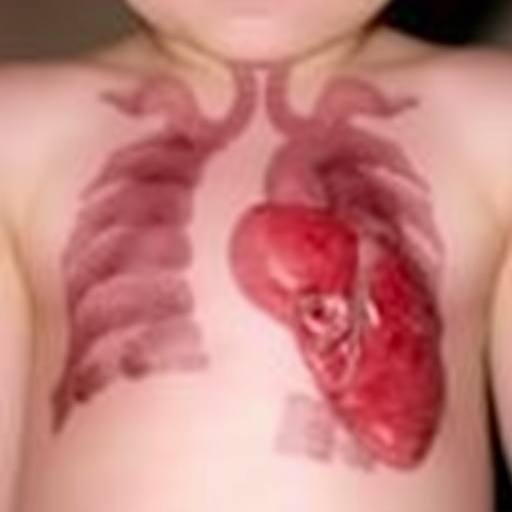In the ever-evolving landscape of cancer biology, the essential metal copper (Cu) has emerged as a double-edged sword, intricately involved in cellular functions that influence both tumor progression and cell death mechanisms. Recent investigations are now shining a spotlight on copper’s complex role in renal cell carcinoma (RCC), one of the most challenging cancers to treat due to its notorious resistance to traditional therapies. The recent study by Abraham Gnanadass and colleagues uncovers groundbreaking insights into two pivotal phenomena: cuproptosis and cuproplasia, processes governed by copper homeostasis, holding enormous potential for reshaping therapeutic strategies in RCC.
Copper is fundamental for numerous biochemical pathways, acting as a critical cofactor in enzymatic reactions required for cell survival. However, it demands a rigorously maintained intracellular balance, as any departure from homeostasis can have profound effects. Dysregulation of copper in RCC has long been suspected to play a pivotal role in oncogenesis, yet the detailed molecular underpinnings have remained obscure. Emerging evidence places cuproptosis—a novel form of programmed cell death triggered by copper accumulation—at the vanguard of innovative cancer therapies. Simultaneously, cuproplasia describes copper-driven cell proliferation, fostering tumor growth. Understanding where the line is drawn between these opposing outcomes remains an exhilarating frontier.
A core challenge lies in determining the precise threshold of copper concentrations that shifts cellular fate from survival and proliferation to irreversible death. This threshold is not merely a quantitative measure; it reflects the intricate network of molecular switches that regulate copper’s dualistic influence on RCC cells. Decoding these regulatory nodes offers unprecedented opportunities to exploit copper’s cytotoxic potential while curtailing its tumor-promoting effects. Yet, definitive experimental data pinpointing this threshold remain absent, compelling researchers to probe deeper into the molecular circuits modulating copper-dependent cellular states.
The current research landscape is increasingly leveraging machine learning and sophisticated bioinformatics approaches to unravel copper’s multifaceted roles in RCC. Computational models examining cuproptosis-linked gene signatures have revealed promising correlations with clinical outcomes, underscoring the potential prognostic and predictive value of copper-regulated pathways. However, this surge in in silico data necessitates rigorous experimental validation to translate theoretical models into tangible clinical interventions. Bridging this gap between computational predictions and laboratory findings forms the cornerstone of advancing copper-based oncology therapies.
Although the concept of copper inducing cuproplasia—a pro-tumorigenic process—is still largely hypothetical, its implications in RCC are profound. Experimental validation is urgently needed to elucidate how copper-driven proliferation specifically contributes to the heterogeneity in RCC subtypes. Furthermore, unraveling the association between copper-mediated processes and mechanisms of drug resistance in RCC cells could illuminate new avenues to bypass therapeutic obstacles. The metabolic reprogramming induced by fluctuating copper levels presents another tantalizing aspect, potentially altering tumor bioenergetics to sustain malignancy.
The tumor immune microenvironment (TME) is an additional domain where copper’s role remains enigmatic but potentially transformative. Copper’s interaction with immune cells infiltrating RCC tumors might mediate immune evasion or provide susceptibility to immune checkpoint inhibitors. Deciphering these interactions will be crucial for integrating copper-centered treatments with contemporary immunotherapies, thereby enhancing their efficacy and specificity. The identification of key genes orchestrating RCC progression through copper-dependent pathways also remains a priority, offering molecular targets for drug development.
Clinical trials investigating copper-based therapies in RCC are nascent yet promising. Preclinical models consistently demonstrate copper’s ambivalent nature—exerting oncogenic influence under certain contexts while promoting cytotoxicity under others. This duality suggests that future clinical protocols must adopt combination strategies, potentially pairing copper modulators with established agents such as VEGF inhibitors, which have revolutionized RCC treatment. Likewise, combining copper-directed agents with immune checkpoint blockade could harness synergistic effects, optimizing patient outcomes through personalized therapeutic regimens.
The lack of precise, experimentally validated biomarkers that can predict when copper’s influence shifts from tumorigenic to tumoricidal complicates both research and clinical translation. Developing such biomarkers will be instrumental in patient stratification, allowing clinicians to identify individuals who would most benefit from copper-targeted interventions. Likewise, understanding the spatiotemporal dynamics of copper homeostasis within RCC tissues could illuminate new intervention points, offering a window into tailoring treatments based on tumor microenvironmental cues.
Recent advances in molecular biology techniques, including CRISPR-based gene editing and advanced imaging modalities, equip researchers with unprecedented tools to dissect copper-related pathways at cellular and subcellular resolution. Such approaches will enable precise manipulation of copper transporters, chaperones, and cuproptosis regulators, thereby refining our understanding of copper-induced cellular phenomena. Moreover, integration with metabolomics and proteomics datasets will unravel copper’s broad impact on cellular metabolism and proteostasis, further enriching the molecular narrative.
Understanding the fundamental biochemical framework of cuproptosis is vital, as this newly characterized cell death mechanism diverges significantly from classical apoptosis, necroptosis, and ferroptosis. Cuproptosis is closely tied to mitochondrial function, particularly in relation to iron-sulfur cluster proteins and lipoylated components of the tricarboxylic acid (TCA) cycle. Disruptions in these mitochondrial processes via copper overload trigger lethal proteotoxic stress, culminating in cell demise. This mechanism offers a unique vulnerability in RCC cells reliant on oxidative phosphorylation, presenting a stark contrast to glycolysis-dependent tumors where copper’s role might be less pronounced.
Conversely, cuproplasia encapsulates copper’s capacity to fuel cellular proliferation, amplifying oncogenic signaling pathways that promote growth and survival. The molecular determinants tipping the balance toward this proliferative state—including potential feedback loops and checkpoint regulators—remain undefined. Addressing these knowledge gaps would allow researchers to manipulate copper flux within tumors tactically, ideally suppressing proliferative cues while inducing cuproptotic cell death.
The translational potential of copper-directed therapies extends beyond RCC, capturing interest across various malignancies characterized by aberrant copper metabolism. The dualistic nature of copper offers a therapeutic window that, if precisely targeted, could selectively eliminate cancer cells while sparing normal tissue. However, the challenge lies in designing agents with fine specificity for copper homeostasis components—transporters, storage proteins, or chaperones—limiting off-target toxicity. The dynamic and context-dependent behavior of copper in tumors underscores the necessity for integrating molecular profiling into treatment planning.
Continued research is expected to redefine the role of copper in RCC through multidisciplinary collaborations, merging computational predictions with mechanistic studies and clinical explorations. As the field progresses, it is likely that effective copper modulators will complement the current arsenal of targeted therapies and immunotherapies, contributing to precision oncology paradigms where treatment is tailored to the unique copper metabolism status of individual tumors. This new horizon offers hope for overcoming RCC’s therapeutic resistance and improving patient survival rates.
In conclusion, the dual roles of copper in promoting cell proliferation and triggering a distinct form of programmed cell death expose an intricate balance ripe for therapeutic exploitation. While computational and preclinical data have illuminated the possibilities, the field stands at a critical juncture requiring robust experimental validation and carefully designed clinical trials. By elucidating the molecular switches that govern cuproptosis and cuproplasia, and innovatively combining copper-based agents with existing therapies, the oncology community may unlock a new frontier in RCC treatment, with broader implications across cancer biology.
Subject of Research: Understanding the roles of copper-induced cuproptosis and cuproplasia in renal cell carcinoma to develop targeted therapeutic strategies.
Article Title: Decoding cuproptosis and cuproplasia: implications for therapeutic strategies in renal cell carcinoma
Article References:
Abraham Gnanadass, S., Pandey, S. & Viswanathan, P. Decoding cuproptosis and cuproplasia: implications for therapeutic strategies in renal cell carcinoma.
Cell Death Discov. 11, 501 (2025). https://doi.org/10.1038/s41420-025-02734-z
DOI: 10.1038/s41420-025-02734-z
Image Credits: AI Generated
Tags: biochemical pathways of coppercancer biology advancementscopper homeostasis in cancer therapycopper’s role in tumor progressioncuproplasia and tumor growthcuproptosis in renal cell carcinomainnovative insights into RCC treatmentmolecular mechanisms of oncogenesisnovel cancer treatment strategiesprogrammed cell death mechanismsresistance to traditional cancer therapiestherapeutic implications of copper dysregulation





